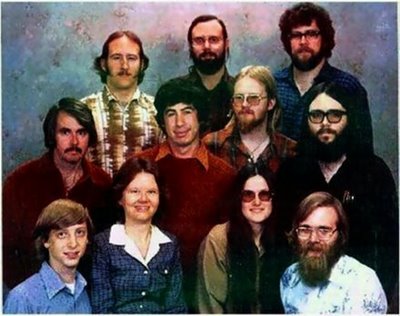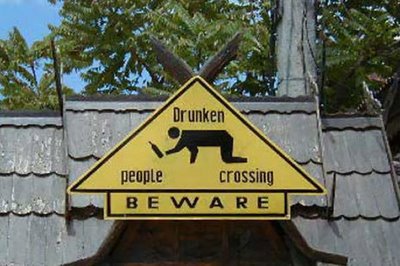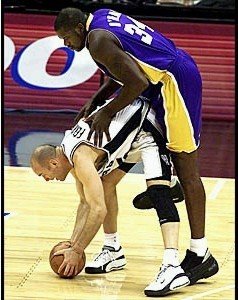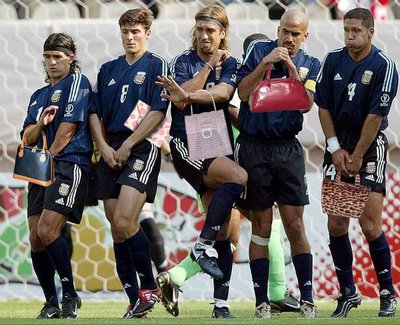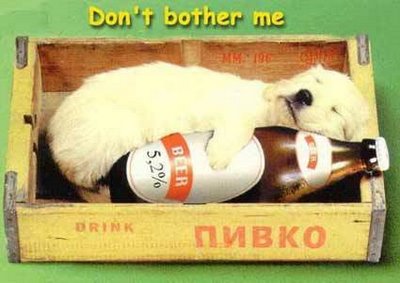Tuesday, October 31, 2006
Horrible Halloween picks for the ghastliest gizmos, scariest software and most terrifying technologies of the year.
PC makers have recalled 9.6 million Sony-made notebook and laptop batteries so far this year for a rare but spectacular tendency to overheat and burst into flames. In money terms, the recalls cost Sony 51 billion yen (about $433 million). In reputation, though, the cost was higher: Sony's reputation for quality went up in flames. And who at Sony decided to tough it out, letting one PC maker after another announce recalls over a period of weeks, instead of getting the bad news dealt with all at once? It turns out, according to Japanese newspapers, that Sony knew of the manufacturing defects in Dell batteries as long as a year ago, but didn't bother to inspect batteries made for other computer makers. Adding to Sony's woes: Prototypes of the PlayStation 3 game console, scheduled to make its Japanese and American debut on Nov. 17, malfunctioned last month at the Tokyo Game Show, reportedly because of overheating. Not a good omen.
Posted by
Sucharitha
at
9:36 PM
0
comments
![]()
![]()
Public speaking
When it comes to fears, public speaking ranks right up there with death or finding yourself sitting between Lou Dobbs and Bill Maher on a cross-country plane trip. But there's nothing to be afraid of, says Richard Greene, author of "Words That Shook the World," as long as you've got a game plan. Greene points the way.
Prepare your head. "Be physically energized and centered before you walk in the room," says Greene. If your energy level is low, do some physical activity beforehand to invigorate yourself. Take deep breaths to calm any nervousness.
It's not a performance. "People have a flawed perception of what speaking is about," says Greene. "The greatest speakers, like F.D.R., Reagan, and Clinton, approach it as a conversation with the audience."
Podiums are for dictators and high school principals. Standing behind a podium disconnects you from the audience and may worsen fragile nerves. Instead, grab the mike and wander the stage or room, or at least step to the side of the podium and lean against it.
Dress the audience. Picturing the audience naked is actually "one of the worst things you can do," Greene says. How comfortable would you feel chatting with the naked guy in the gym locker room?
Eye contact is your friend. "You're speaking to individual people," Greene says. Looking at them one by one shrinks the room.
Don't sweat the questions. If you're stumped, "regard it as a positive," Greene coaches. Seize the opportunity to talk about your team: "We're lucky to have one of the real experts on that subject. I'll get you in touch with him or her later."
Posted by
Sucharitha
at
9:31 PM
0
comments
![]()
![]()
Top 10 Boss Sins and Boss Insecurity
• Tries too hard to be everyone's friend
These so-labeled sins are a bit vague (“unprofessional” can translate into anything from sexual harassment to being unresponsive), but they’re probably a good starting point to figuring out where your situation lies -- whether you are a boss or a direct report.
On a related note, this CNN.com article delves into how one should handle an insecure boss -- you know, the type who is most likely underqualified with a Napoleonic complex against subordinates.
According to the article, “insecurity is one of the most common causes of managers behaving oddly… They'll do anything to make themselves feel better, even if it's at your expense.” Sound familiar?
The article goes on to offer up a few rather manipulative ways to thwart such a boss (i.e., continuously massage their ego). But from my experience of just watching folks try to do this, it looks exhausting. Do you really want to waste your time at work making someone feel better about the fact they aren’t qualified for their job? Hate to sound harsh, but this pattern of behavior can really start affecting a company’s bottom line, don’t you think?
Complete article can be read at CNN.com or use the below link:
http://money.cnn.com/2006/10/12/commentary/sahadi/index.htm?postversion=2006101212
Posted by
Sucharitha
at
8:43 PM
0
comments
![]()
![]()
10 Tips To Healthy Eating
Experts agree the key to healthy eating is the time-tested advice of balance, variety and moderation. In short, that means eating a wide variety of foods without getting too many calories or too much of any one nutrient. These 10 tips can help you follow that advice while still enjoying the foods you eat.
- Eat a variety of nutrient-rich foods. You need more than 40 different nutrients for good health, and no single food supplies them all. Your daily food selection should include bread and other whole-grain products; fruits; vegetables; dairy products; and meat, poultry, fish and other protein foods. How much you should eat depends on your calorie needs. Use the Food Guide Pyramid and the Nutrition Facts panel on food labels as handy references.
- Enjoy plenty of whole grains, fruits and vegetables. Surveys show most Americans don't eat enough of these foods. Do you eat 6-11 servings from the bread, rice, cereal and pasta group, 3 of which should be whole grains? Do you eat 2-4 servings of fruit and 3-5 servings of vegetables? If you don't enjoy some of these at first, give them another chance. Look through cookbooks for tasty ways to prepare unfamiliar foods.
- Maintain a healthy weight. The weight that's right for you depends on many factors including your sex, height, age and heredity. Excess body fat increases your chances for high blood pressure, heart disease, stroke, diabetes, some types of cancer and other illnesses. But being too thin can increase your risk for osteoporosis, menstrual irregularities and other health problems. If you're constantly losing and regaining weight, a registered dietitian can help you develop sensible eating habits for successful weight management. Regular exercise is also important to maintaining a healthy weight.
- Eat moderate portions. If you keep portion sizes reasonable, it's easier to eat the foods you want and stay healthy. Did you know the recommended serving of cooked meat is 3 ounces, similar in size to a deck of playing cards? A medium piece of fruit is 1 serving and a cup of pasta equals 2 servings. A pint of ice cream contains 4 servings. Refer to the Food Guide Pyramid for information on recommended serving sizes.
- Eat regular meals. Skipping meals can lead to out-of-control hunger, often resulting in overeating. When you're very hungry, it's also tempting to forget about good nutrition. Snacking between meals can help curb hunger, but don't eat so much that your snack becomes an entire meal.
- Reduce, don't eliminate certain foods. Most people eat for pleasure as well as nutrition. If your favorite foods are high in fat, salt or sugar, the key is moderating how much of these foods you eat and how often you eat them. Identify major sources of these ingredients in your diet and make changes, if necessary. Adults who eat high-fat meats or whole-milk dairy products at every meal are probably eating too much fat. Use the Nutrition Facts panel on the food label to help balance your choices. Choosing skim or low-fat dairy products and lean cuts of meat such as flank steak and beef round can reduce fat intake significantly. If you love fried chicken, however, you don't have to give it up. Just eat it less often. When dining out, share it with a friend, ask for a take-home bag or a smaller portion.
- Balance your food choices over time. Not every food has to be "perfect." When eating a food high in fat, salt or sugar, select other foods that are low in these ingredients. If you miss out on any food group one day, make up for it the next. Your food choices over several days should fit together into a healthy pattern.
- Know your diet pitfalls. To improve your eating habits, you first have to know what's wrong with them. Write down everything you eat for three days. Then check your list according to the rest of these tips. Do you add a lot of butter, creamy sauces or salad dressings? Rather than eliminating these foods, just cut back your portions. Are you getting enough fruits and vegetables? If not, you may be missing out on vital nutrients.
- Make changes gradually. Just as there are no "superfoods" or easy answers to a healthy diet, don't expect to totally revamp your eating habits overnight. Changing too much, too fast can get in the way of success. Begin to remedy excesses or deficiencies with modest changes that can add up to positive, lifelong eating habits. For instance, if you don't like the taste of skim milk, try low-fat. Eventually you may find you like skim, too.
- Remember, foods are not good or bad. Select foods based on your total eating patterns, not whether any individual food is "good" or "bad." Don't feel guilty if you love foods such as apple pie, potato chips, candy bars or ice cream. Eat them in moderation, and choose other foods to provide the balance and variety that are vital to good health.
Posted by
Sucharitha
at
7:07 PM
0
comments
![]()
![]()
American Jobs, American Problems
I'm not ready to say that India was an idyllic place before American and European call centers and offshore technology offices began sprouting up over the past decade. But there are a couple of recent news stories out of the subcontinent that make you wonder.
Recent polls of Indian call center workers found more office hanky-panky and drug use than Indians are accustomed to.
Shankar Rao, deputy commissioner of the New Delhi Police, suggested that the call centers provide counseling to keep staffers off drugs and sex and that they should make sure no one works more than three nights a week.India's drug problem appears to be growing, and while the call centers probably aren't directly responsible, the nation's growing economy and infusion of disposable income seem partly to blame.
Says Kiran Bedi, who heads the Navjyoti Rehabilitation Centre in Delhi, "One of the biggest reasons for drug addiction is peer pressure. Being in the company of people who have loose money instigates one to adopt a similar lifestyle. Drug peddling and drug abuse are inter-related. To be able to sustain drug abuse, drug peddling becomes necessary because that is how the money to buy the costly drugs comes."This is the same phenomenon documented by American rapper Biggie Smalls in his hit "Mo' Money Mo' Problems."
Posted by
Sucharitha
at
1:45 PM
0
comments
![]()
![]()
Sunil Shetty - My Fav



Suniel Shetty (born 11 August 1961) is an Indian actor. He was born in MULKI,Mangalore, Karnataka, India. He was formerly known as Sunil Shetty before changing his name.
Personal life
Sunil is married to Manna and has two children named Atiya and Aahan. He is black belt in Full Contact Kick boxing.He is also a sucessful business man owning a hotel chain and also owns MISCHIEF garment outlet.

He made his debut in films in 1992 with "Balwann" opposite Divya Bharati. He worked with all the stars both males and females and the directors in the Bollywood.
Sunil Shetty, the LEO man, is best known for his style in thrills - the way he manhandles the villain group and executes the fights. And he's known for his gentlemanly attitude off the screen too.

Sunil Autograph

Posted by
Sucharitha
at
12:59 PM
0
comments
![]()
![]()
Dr. A.P.J. Abdul Kalam
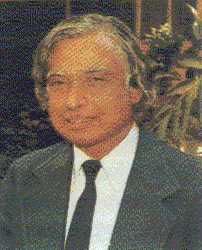
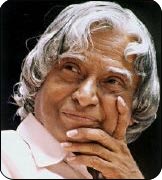
Avul Pakir Jainulabdeen Abdul Kalam , born October 15, 1931, Tamil Nadu, India, usually referred to as Dr. A.P.J. Abdul Kalam is the current President of India. A notable scientist and an engineer, he is often referred to as the Missile Man of India.
In office since:July 25, 2002
Vice President(s) :Bhairon Singh Shekhawat
Preceded by:K. R. Narayanan
Succeeded by:Incumbent
Political party:Independent
Spouse:Celibate
Religion:Islam
Career
Abdul Kalam was born on 15th October 1931 at Rameswaram in Dhanushkodi, Tamil Nadu, to a working class Tamil Muslim family. He received his degree in aeronautical engineering from the Madras Institute of Technology in 1958. He joined India's Defence Research and Development Organisation (DRDO) upon graduation to work on a hovercraft project. In 1962, Kalam moved to the Indian Space Research Organisation (ISRO), where his team successfully launched several satellites. He made a significant contribution as Project Director to develop India's first indigenous Satellite Launch Vehicle (SLV-III) which successfully placed the Rohini satellite into near earth orbit in July 1980.
In 1982, Kalam returned to the DRDO as Director, focusing on Indigenous guided missiles. He was responsible for the development and operationalisation of the AGNI and PRITHVI missiles. This earned him the sobriquet "India's missile-man". He also helped in the formulation of healthcare products using technology developed for missiles.
In July 1992, Kalam became a Scientific Advisor to India's Defence Minister. As the Principal Scientific Advisor to the Indian government, he held the rank of a Cabinet Minister. His work led to the successful Pokhran-II nuclear tests in 1998, which reiterated India's position as a nuclear weapon state. Kalam was also the Chairman, Ex-officio, of the Scientific Advisory Committee to the Cabinet (SAC-C) and piloted the "India Millennium Mission 2020".
Kalam later took up academia as a Professor of Technology & Societal Transformation at Anna University, Chennai from November 2001 and was involved in teaching and research tasks. Above all, he took up a mission to ignite the young minds for national development by meeting young school students across the country.
Kalam was elected the 11th President of India and took office on July 25, 2002.
Honours
Kalam has the unique distinction of having received honorary doctorates from at least thirty universities, as also India's three highest civilian honours: the Padma Bhushan in 1981; the Padma Vibhushan in 1990; and the Bharat Ratna in 1997. He has recently refused an honorary doctorate from a University, stating he is satisfied with the ones he has earned with his hard work and determination.
Political views
Something of Kalam's probable views on certain issues can be surmised from positions espoused by him in the past. His book "India 2020" strongly advocates an action plan to develop India into a knowledge superpower and into a developed nation by the year 2020. Kalam is credited with the view that India ought to take a more assertive stance in international relations; he apparently regards his work on India's nuclear weapons program as a way to assert India's place as a future superpower.
Kalam continues to take an active interest in other developments in the field of science and technology as well. He has proposed a research programme for developing bio-implants. He is a supporter of Open source software over proprietary solutions and believes that the use of open source software on a large scale will bring more people the benefits of information technology
Personal life
Kalam observes strict personal discipline, practicing vegetarianism, teetotalism and celibacy. Kalam is a scholar of Tirukkural; in most of his speeches, he quotes at least one kural. He reads the Qur'an (the main holy text of his faith, Islam) regularly. He is believed to recite the Bhagvad Gita daily.Kalam has written several inspirational books, most notably his autobiography Wings of Fire, aimed at motivating Indian youth. Another of his books, Guiding Souls: Dialogues on the Purpose of Life reveals his spiritual side. It has been reported that there is considerable demand in South Korea for translated versions of books authored by him
Trivia
He loves children, and encourages their audiences with him.
On Tuesday, 14 February, 2006, he created history by becoming the country's first President to undertake an undersea journey. Abdul Kalam boarded the INS Sindhurakshak, a Russian-origin kilo class submarine, from the Visakhapatnam Naval dockyard. The duration of the journey was around three-and-half hours during which Kalam had lunch with the crewmembers.
He did his college studies at the Madras Institute of Technology, where he used to head the vegetarian mess.
Initially he wanted to become a pilot, but was rejected and then opted for aeronautical engineering later.
On Thursday, 08 June, 2006, he created history by becoming the country's first president to undertake a sortie in an aircraft, the Sukhoi-30 MKI, the latest supersonic fighter aircraft, from Lohegaon (Pune) airbase. As a 74-year old, he created a record by becoming the oldest Indian co-pilot to do so. The president donned a G Suit before boarding the aircraft, and was also given instructions by Air Force officials. He was strapped in by Corporal H L Ganesh. He flew at a height of six to eight kilometers in the air at a speed of 1500Km/Hr. The flight lasted 30 minutes. Wing Commander Ajay Rathore, Commanding Officer of the SU-30 MKI squadron flew the President.
His popularity among Indian youth can be gauged from the fact that his request to re election as president petition in Petition Online site is the one of the Top 10 petitions for the past several days.
As a sign of his popularity among Indian youth, MTV-India recently nominated him as one of the prospectives for its MTV India Youth Icon for the year 2006 Award
If you want more information on Dr.Kalam visit the links below:
http://presidentofindia.nic.in/scripts/presidentprofile.jsp
http://www.abdulkalam.com/
http://www.geocities.com/siafdu/kalam.html
Posted by
Sucharitha
at
12:31 PM
0
comments
![]()
![]()
Government of India
India's bicameral parliament (also known as the Sansad) consists of the Rajya Sabha (Council of States) and the Lok Sabha (House of the People). The Union Council of Ministers is responsible to the Lok Sabha. In India's parliamentary system, the executive is nominally subordinate to the legislature. There are 543 members in the Lok Sabha that are elected from the various states on the basis of proportional representation. There are 2 Anglo-Indian members nominated by the President. The Rajya Sabha has 250 members.
The Executive arm consists of the President, Vice-President, the Prime Minister and the Council of Ministers. Any minister holding a portfolio must be a member of either house of parliament.
The government exercises its broad administrative powers in the name of the President of India, who is the Supreme Commander of the Armed Forces, the Head of State and chief guardian of the Constitution of the Republic.
The President's true role is mostly ceremonial. He is the Supreme Commander of the nation's armed forces, has the authority to dissolve Parliament and call fresh elections, declare a state of emergency, and dismiss governments in the states, but all upon the counsel of the Prime Minister and the elected government.
Historically, the President of the Republic has been a person revered by the people for his position above ordinary politics. The President and Vice President are elected indirectly for 5-year terms by a special electoral college, composed of delegates from the federal Parliament and state legislatures.
The Ministers may be of 3 types - Cabinet Minister, Minister of State (Independent Charge) and Minister of State, in order of seniority. Cabinet Ministers and Ministers of State with independent charge may usually attend Cabinet meetings.
Ministry of Agriculture
Ministry of Agro and Rural Industries
Ministry of Chemicals and Fertilizers
Ministry of Civil Aviation
Ministry of Coal
Ministry of Commerce and Industry
Ministry of Communications and Information Technology
Ministry of Company Affairs
Ministry of Consumer Affairs, Food and Public Distribution
Ministry of Defence
Ministry of Development of North Eastern Region
Ministry of Environment and Forests
Ministry of External Affairs
Ministry of Finance
Ministry of Food Processing Industries
Ministry of Health and Family Welfare
Ministry of Heavy Industries and Public Enterprises
Ministry of Home Affairs
Ministry of Housing and Urban Poverty Alleviation
Ministry of Human Resource Development
Ministry of Information and Broadcasting
Ministry of Labour and Employment
Ministry of Law and Justice
Ministry of Mines
Ministry of Minority Affairs
Ministry of Non-Conventional Energy Sources
Ministry of Ocean Development
Ministry of Overseas Indian Affairs
Ministry of Panchayati Raj
Ministry of Parliamentary Affairs
Ministry of Personnel, Public Grievances and Pensions
Ministry of Petroleum and Natural Gas
Ministry of Power
Ministry of Railways
Ministry of Rural Development
Ministry of Science and Technology
Ministry of Shipping, Road Transport and Highways
Ministry of Small Scale Industries
Ministry of Social Justice and Empowerment
Ministry of Statistics and Programme Implementation
Ministry of Steel
Ministry of Textiles
Ministry of Tourism and Culture
Ministry of Tribal Affairs
Ministry of Urban Development
Ministry of Water Resources
Ministry of Women and Child Development
Ministry of Youth Affairs and Sports
The Constitution of India also provides for following independent organisations, which are answerable only to the Parliament and are not under the purview of any Ministry,
Central Bureau of Investigation (CBI) - premier national investigative agency, analogous to the United States FBI, but limited in authority.
Central Vigilance Commission (CVC)
Comptroller and Auditor General of India (CAG)
Election Commission of India
National Commission for Women
National Commission on Population
National Human Rights Commission (NHRC)
Planning Commission - The premier agency
Telecom Regulatory Authority of India (TRAI) - Telecom regulator
Union Public Service Commission (UPSC) - The recruitment agency for civil service positions
The Preamble lays down the type of government that India has adopted - Sovereign, Socialist, Secular, Democratic, Republic.
Sovereign
The word sovereign means supreme or independent. India is internally and externally sovereign - externally free from the control of any foreign power and internally, it has a free government which is directly elected by the people, which makes laws which governs the people.
The word socialist was added to the Preamble by the 42nd Amendment Act of 1976. It implies social and economic equality for all its citizens. There will be no discrimination on the basis of caste, colour, creed, sex, religion, language etc. Everybody will be given equal status and opportunities. The government will make efforts to reduce the concentration of wealth in a few hands, and provide a decent standard of living to all.
India has adopted a mixed economic model, and the government has framed many laws to achieve the goal of socialism, such as Abolition of Untouchability and Zamindari Act, Equal Wages Act and Child Labour Prohibition Act.
The word secular was inserted into the Preamble by the 42nd Amendment Act of 1976. It implies equality of all religions and religious tolerance. India does not have any official state religion. Every person has the right to preach, practice and propagate any religion of their own choice. The government does not favour or discriminate any religion. It treats all religions with equal respect. All citizens, irrespective of their religious beliefs are equal in the eyes of law. No religious instruction is imparted in government or government - aided schools. Contrary to this, India made laws based on religion and sub-religion (caste).
India is a democratic country. It is often referred to as the largest democracy in the world, and takes pride in that designation. People of India elect their governments at all levels (central, state and local) by a method of universal adult franchise. Every citizen of India, who is 18 years of age and above and who is not otherwise debarred by law, is entitled to vote. Every citizen enjoys this right without any discrimination on the basis of caste, creed, colour, sex, religion or education.
Though every citizen is entitled to vote, but not everyone can stand for election from any location, specific seats are allocated for Scheduled castes and Scheduled tribes (22%) in parliament called (reserved constituencies), in local body election a percentage of seats are allocated for women candidate.
There is also a proposal to allocate 33% seats in all elections to woman candidates, currently there is no consensus in how to implement it and which seats should be allocated.
The pillar of Indian Democracy is Election Commission of India, it is one of the most trusted organisations and has been praised by all for conducting Free and Fair elections.
Republic
As opposed to a monarchy, in which the head of state is appointed on hereditary basis for a lifetime, or till he abdicates, a republic is a state in which the head of state is elected, directly or indirectly, for a fixed tenure. The President of India is elected by an electoral college for a term of five years.
Posted by
Sucharitha
at
12:10 PM
0
comments
![]()
![]()
Monday, October 30, 2006
History of India
Stone Age rock shelters with paintings at Bhimbetka
 Bhimbetka Rock Paintings
Bhimbetka Rock Paintingsin the state of Madhya Pradesh are the earliest known traces of human life in India. The first known permanent settlements appeared over 9,000 years ago and gradually developed into the Indus Valley Civilization, dating back to 3300 BCE in western India. It was followed by the Vedic Civilization which laid the foundations of Hinduism and other cultural aspects of early Indian society. From around 550 BCE, many independent kingdoms and republics known as the Mahajanapadas were established across the country laying the foundations of ancient India.
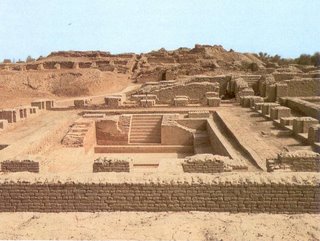
The empire built by the Maurya dynasty under Emperor Ashoka the Great united most of modern Southern Asia except the Dravidian kingdoms in the south and laid the first foundation of a united subcontinental territory. From 180 BCE, a series of invasions from Central Asia into the north-western Indian Subcontinent followed, including the Indo-Greeks, Indo-Scythians, Indo-Parthians and the Kushans. From the third century CE, the Gupta dynasty oversaw the period referred to as ancient India's "Golden Age." While the north had larger, fewer kingdoms, in the south there were several dynasties such as the Chalukyas, Rashtrakutas, Hoysalas, Cheras, Cholas, Pallavas and Pandyas in different times and regions. The political influence of these mighty southern kingdoms, though felt to a lesser extent by north India, extended into Southeast Asia and Sri Lanka and deeply influenced their culture. The southern kingdoms remained relatively more stable and carried out maritime trade in spices and precious gems with the Arabia, China and Europe from ancient times. Science, engineering, art, literature, mathematics, astronomy, religion and philosophy flourished under the patronage of these kings.
The Sanchi stupa in Sanchi, Madhya Pradesh built by emperor Ashoka in the 3rd century BC
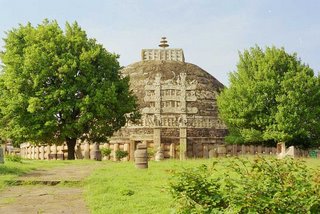
Following the invasions from Central Asia, between the tenth to the twelfth centuries, much of north India came under the rule of the
By the early twentieth century, a nationwide movement for social reforms, expulsion of the British, and full native governance was launched by the Indian National Congress, and various revolutionary groups. The movement was largely led by Mahatma Gandhi, with Maulana Azad, Gopal Krishna Gokhale, Lala Lajpat Rai, Bal Gangadhar Tilak, Sardar Vallabhbhai Patel, Jawaharlal Nehru, Bipin Chandra Pal and Subhash Chandra Bose playing important roles. Millions protested in various mass campaigns of civil disobedience where a very prominent philosophy was of ahimsa or non-violence. There were also numerous armed attempts by the likes of the Chapekar brothers, Bhagat Singh, Udham Singh, Sukhdev, Rajguru, Kshudiram Das, Benoy, Badal and Dinesh, and an army of Indian soldiers under Netaji Subhash Chandra Bose used revolutionary or military means to rid India of the British. Finally, after the Quit India movement during WWII and a number of mutinies in the armed forces after the war, the British colonial authority ended with the emergence of India as a modern secular democratic nation-state on 15 August 1947. This period also sowed the seeds of another nation - Pakistan, and after a blood-stained partition, the Muslim majority regions were carved out to form Pakistan with its two wings separated by thousands of miles of Indian territory. Three years later, on 26 January 1950, India ratified a new Constitution, and became a republic. Modern India thus emerged as a amalgamation of western democracy while preserving its ancient heritage laid in its first foundation in 321 BCE during Emperor Ashoka the Great's Mauryan Empire.
Since it became a democratic nation-state, India has seen sectarian violence and insurgencies in various parts of the country, but has maintained its unity and democracy. It has unresolved territorial disputes with China, which escalated into the brief Sino-Indian War in 1962; and with Pakistan, which resulted in wars in 1947, 1965, 1971 and in 1999 war in Kargil. The 1971 war resulted in the surrender of East Pakistan and the independence of Bangladesh. India is a founding member of the Non-Aligned Movement and the United Nations (at the time as part of British India). In 1974, India conducted an underground nuclear test. This was followed by five more tests in 1998. Significant economic reforms beginning in 1991 have transformed India into one of the fastest-growing economies in the world.
More Information coming about the :Timeline of Indian History;Military history of India and Indian Independence Movement . STAY Tuned ...
Posted by
Sucharitha
at
11:30 PM
0
comments
![]()
![]()

